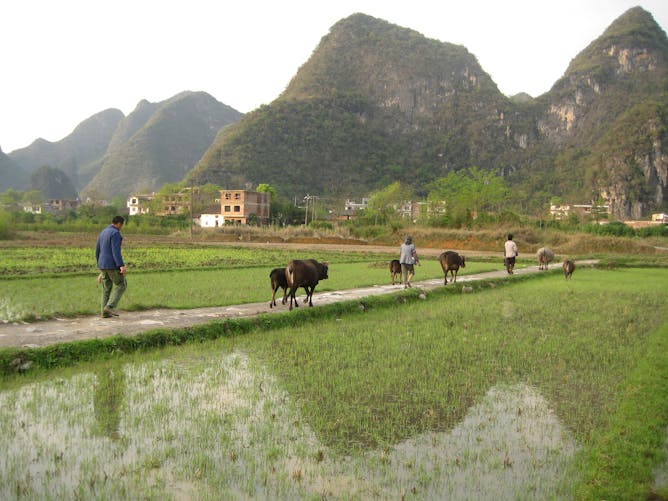|
When it comes to mercury and food, the typical warning is to avoid too much fish. But researchers have discovered that a dangerous form of mercury is entering rice in China at significant levels. Their study found that airborne mercury – a byproduct of burning coal – is the likely culprit. Noelle Eckley Selin and Sae Yun Kwon write that the finding has implications across Asia because the use of coal power is spreading and rice is a staple food.
Forensic investigators seek out hidden DNA evidence at crime scenes. Doctors search for unseen pathogens in patients' blood. Why shouldn't biologists also be able to detect life forms without seeing them? Stefano Mariani and Judith Bakker explain how they've done just that - hunting for the cellular material that sharks leave behind as they move through the oceans - and why it's such a valuable method.
|

Mercury enters rice through local industrial activities and through burning coal.
David Woo
Noelle Eckley Selin, Massachusetts Institute of Technology; Sae Yun Kwon, Pohang University of Science and Technology
Study finds that coal pollution in China is leading to people getting significant levels of mercury poisoning from rice.
|

Normana Karia / shutterstock
Stefano Mariani, University of Salford; Judith Bakker, University of Salford
We cannot spot every shark in the ocean. But we can detect their 'environmental DNA'.
|
Arts + Culture
|
-
Martyn Dean Cooke, Manchester Metropolitan University
Arthur Wharton, Walter Tull, Hassan Hegazi, Mohammed Salim and Frank Soo each made footballing history and their stories deserve to be better known.
|
|
Environment + Energy
|
-
Kristof Titeca, University of Antwerp
Locations like border towns as well as people acting as middlemen provide key insights into Uganda's ivory trade.
-
Theresa Laverty, Colorado State University
Scientists often use animals and plants as indicators to assess whether ecosystems are polluted. Tracking bats, which cover wide areas and need clean water, could become a way to find potable water.
|
|
Politics + Society
|
-
Gerhard Schnyder, Loughborough University
Russian politics depends on a competition between different power networks. And hardline nationalists are winning at the expense of reformers.
-
Scott Lucas, University of Birmingham; Umer Karim, University of Birmingham
Years of mediation by Russia have helped keep a direct Israeli-Iranian conflict off the agenda. But things have changed.
|
|
Science + Technology
|
-
Adam Brumm, Griffith University
Humans butchered a rhino in a remote part of the Philippines 700,000 years ago, but who were they and how did they get there?
|
|